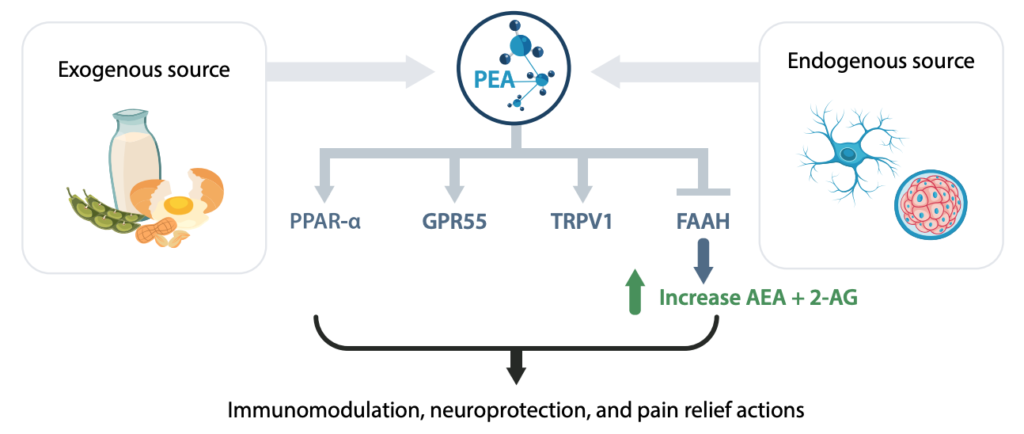Introduction
The endocannabinoid system (ECS) is an important biological system that regulates and balances a wide range of physiological functions in the body.1 Research on the ECS has led to the identification of not only endocannabinoids such as anandamide (AEA) and 2-arachidonoylglycerol (2-AG), but also endocannabinoid-like lipid mediators such as palmitoylethanolamide (PEA). These endocannabinoid-like compounds often share the same metabolic pathways of endocannabinoids but lack binding affinity for the classical cannabinoid receptor type 1 and type 2 (CB1 and CB2).5
| Download the PDF |
PEA naturally occurs in lipid extracts of foods such as egg yolk, peanut oil, and soybean lecithin.10 Endogenously, PEA (fatty acid amide of palmitic acid) is synthesized in various body fluids and cell types, such as immune cells, neurons, and microglia. These cells are relevant to chronic pain and inflammation signaling.5 When facing external stressors such as tissue damage and inflammation, endogenous levels of PEA change in order to maintain cellular homeostasis.11
However, in chronic pathological situations, endogenous PEA levels may be inadequate to address the imbalance and to maintain homeostasis.11 In these cases, supplementation of exogenous PEA has been demonstrated to provide antinociceptive activities, antidepressant actions, and inhibition of peripheral inflammation as well as neuroprotective actions in several preclinical studies.2-4
Research highlights
✓ The endocannabinoid system (ECS) is an important biological system that regulates and balances a wide range of physiological functions in the body.1
✓ Imbalance in the endocannabinoid tone may contribute to the development of several pathological conditions such as psychological and neurodegenerative disorders.2-4
✓ Palmitoylethanolamide (PEA) is an endocannabinoid-like lipid mediator with analgesic and anti-inflammatory properties.5
✓ PEA supports the ECS via modulating endocannabinoid signaling and indirectly activating cannabinoid receptors. This is known as the entourage effect.5-7
✓ The effects of PEA on reducing inflammation and pain are supported by a significant number of clinical studies, and no serious side effects or drug-drug interactions are reported so far. 8,9
Figure 1 . PEA Exerts an entourage effect by interacting with the endocannabinoid system. 3,7
Mechanisms of action
• PEA is produced “on demand” from membrane phospholipids and exerts its pharmacological effects via multiple mechanisms.
• The anti-inflammatory effects of PEA were first identified by modulation of mast cell activation and degranulation.6,12
• Later, the direct receptor activation, including the nuclear receptor peroxisome proliferator-activated receptor-α (PPAR-α) and G-protein coupled receptor 55 (GPR55), was identified (Figure 1). The binding of PEA to selective receptors present on the surface of neurons and immune cells activates signaling pathways leading to inhibition of expression of proinflammatory genes and pain-related signaling, both in the central and peripheral nervous systems.13
In addition, PEA supports the ECS via the entourage effect (Figure 1):
• PEA increases levels of AEA by inhibiting the expression of fatty acid amide hydrolase (FAAH), the enzyme responsible for the breakdown of AEA, thereby indirectly activating classical cannabinoid receptors and increasing AEA actions.6
• PEA enhances 2-AG- and AEA-induced activation and desensitization of the transient receptor potential vanilloid receptor type 1 (TRPV1) channels, thus potentiating TRPV-1-mediated anti-inflammatory or analgesic actions.7
• PEA indirectly increases CB2 receptors expression or activates TRPV1 channel via PPAR-α.5
Increasing numbers of studies indicate that PEA’s therapeutic actions are mediated by synergistic interactions among these mechanisms. For example, in a mouse model of Parkinson’s disease, sustained administration of PEA over 1 week has been shown to protect dopaminergic neurons and ameliorate motor performance.4 These actions may be mediated by PEA acting through both direct and indirect interactions with different receptors, such as cannabinoid receptor CB2 and PPAR-α.14
Clinical benefits
The health benefits of PEA have been studied in many different areas. Key human clinical studies involving PEA are summarized below.
Safety
In a meta-analysis of 12 human clinical studies, PEA was generally well-tolerated, and no serious, nonserious, or suspected adverse events associated with PEA (dose as high as 1,200 mg/day for 365 days) were seen.8,9
Conclusion
PEA has been the subject of numerous preclinical and clinical studies, mainly with a focus on several pathological conditions such as pain, neurodegenerative, and psychological disorders.8,9 With respect to the safety of PEA, no serious side effects or drug-drug interactions have been reported so far.8,9 Further research is needed to better understand pharmacokinetics and potential of PEA in non-pain-related conditions.



